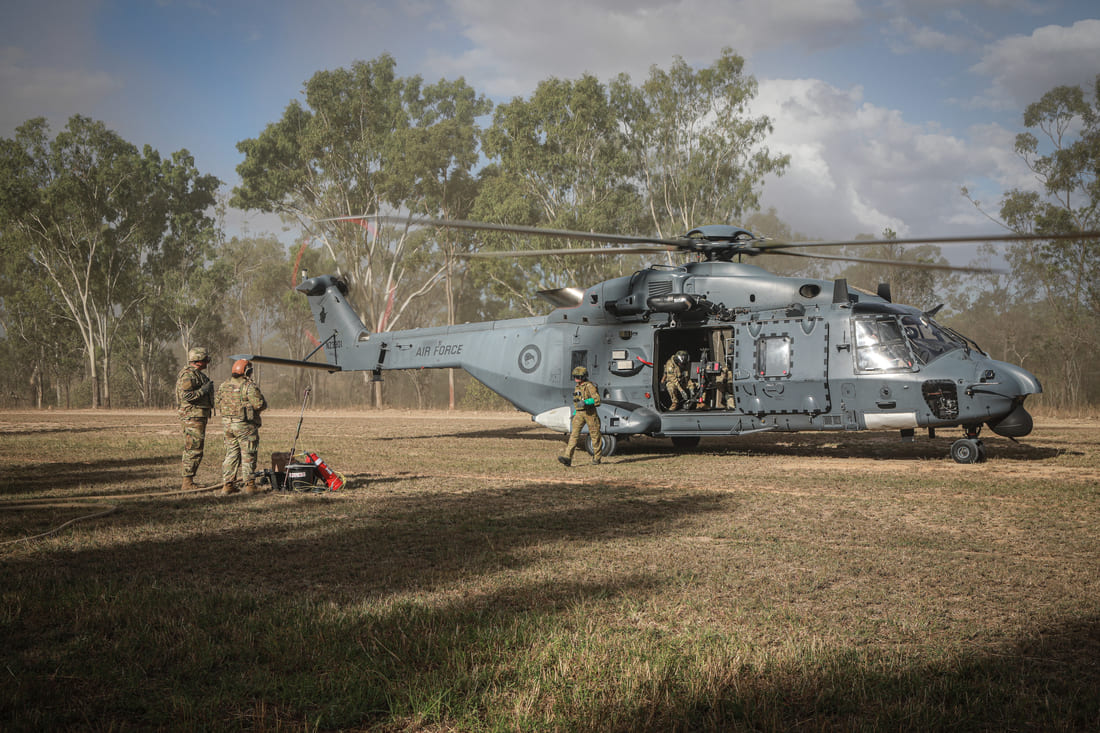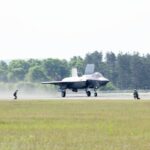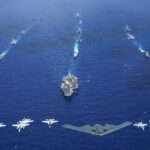Wellington crews brought two Royal New Zealand Air Force NH90s home from Australia on a two-day itinerary that pushed the type’s over-water range across the Tasman. Defense officials confirm 1,534 nautical miles over water from RAAF Base Amberley to RNZAF Base Auckland, with a planned stop at Norfolk Island before recovery to Base Ohakea. The longest leg, Norfolk to Auckland, ran 573 nautical miles in about four and a half hours. Each helicopter used external fuel tanks that New Zealand certified in 2023.
Two No. 3 Squadron airframes finished the trip by the end of September local time. The air force recorded distance and leg timing and noted the pair returned to Ohakea after customs and post-flight checks in Auckland. This closed a months-long deployment that began with Talisman Sabre in Australia, included a detour to Papua New Guinea, then wrapped with the Tasman return.
A new RNZAF mark landed only weeks after the last one. Earlier in September two NH90s flew 453 nautical miles from Cairns to Port Moresby, the farthest the fleet had gone over water until then. That flight ran just under four hours and used the same auxiliary tank setup.
Senior air staff framed the Tasman flight as a deliberate validation of a self-deployment option. Air Component Commander Air Commodore Andy Scott said the result shows utility and the ability to stage across a wide maritime region. Squadron leadership added that it expands long-distance currency among crews who flew the Coral Sea leg in September.
Route and profile across the Tasman Sea
Planning set a ferry path that kept legs inside the tanked endurance window while maintaining alternates. The aircraft launched from Amberley, staged through eastern Australian airfields, then went to Lord Howe Island and Norfolk Island before the final sector to Auckland. The service recorded 1,534 nautical miles over water, about 2,840 kilometers or 1,765 miles. The final leg measured 573 nautical miles and ran roughly 4.5 hours. Both helicopters recovered to Ohakea after ground handling at Auckland.
Weather and headwind data sit outside the official summary, so the air force did not publish average groundspeed. The 4.5 hour leg aligns with a conservative ferry cruise profile with external tanks installed. According to industry sources, standard NH90 cruise sits near 285 km/h in routine utility work, while ferry missions trade speed for endurance when auxiliary tanks are loaded.
Crews used a stepped routing to pair distance with recovery options. The service acknowledged interim stops at Rockhampton and Coffs Harbour on the Australian coast and a hop to Lord Howe Island before the Norfolk leg. This reduced exposure on any single segment before the longest crossing to Auckland.
Fuel planning mirrored the September Cairns-Port Moresby trip. RNZAF pilots described pre-computed fuel graphs with weights and waypoints to track burn against plan. The same method supported timely divert decisions if trends shifted.
Route snapshot:
- Total over-water distance recorded by the service is 1,534 nautical miles. Longest leg Norfolk-Auckland 573 nautical miles, about 4.5 hours
- Equivalent totals 2,840 kilometers or 1,765 miles
- External tanks and NH90 range data
Airframes carried two external auxiliary tanks per helicopter on dedicated stores carriers. The RNZAF equipment data lists two 500-kilogram external tanks as the standard auxiliary fit for long-range work, with an optional 400-kilogram internal tank when the mission permits. In this case the public release specifies the external fit and confirms the certification timeline.
Industry documentation for the NH90 family shows fuel system scaling from internal cells to mixes of internal and external auxiliary tanks. Manufacturer notes list external tanks at roughly 492 kilograms each and internal auxiliary tanks at about 400 kilograms each. Those figures track with RNZAF descriptions and with September’s over-water mission using the same tank arrangement.
Published data places normal-range operations on internal fuel around 680 kilometers for the RNZAF baseline, with endurance near four hours on internal tanks. Ferry range increases with auxiliaries fitted. Open-source manufacturer references list roughly 1,600 kilometers on internal auxiliary tanks alone, before counting external tanks. The Tasman profile sits inside a realistic endurance window for a tanked NH90, which matches the 4.5 hour timing on the longest leg.
External tanks add mass and drag that crews account for in planning. Earlier over-water crews highlighted pre-calculated fuel graphs that fold in aircraft weight and expected trends. The practice helps keep the reserve cushion intact on long blue-water segments.
Configuration summary:
- External auxiliary tanks two per aircraft, about 500 kilograms each. Optional 400-kilogram internal auxiliary tank available
- Normal RNZAF range on internal tanks about 680 kilometers. Ferry range with internal auxiliaries about 1,600 kilometers per manufacturer data
RNZAF NH90 fleet history and use since 2015
Cabinet selected the NH90 in 2005 to replace the UH-1 Iroquois, with a procurement model aimed at commonality with Australia. New Zealand contracted for eight operational aircraft plus one hull for spares, with deliveries in 2011-2014. The fleet entered full service in 2015 with No. 3 Squadron at Ohakea. The equipment listing today still shows eight NH90s in service.
Assigned roles cover tactical air mobility for the joint force and civil-support tasks. The air force cites support to special operations, casualty evacuation, movement of troops and equipment, and frequent assistance to civilian agencies including search and rescue, police operations, disaster relief, and counter-terrorism response. Availability ran high enough for a rare seven-ship formation over Manawatū in May.
Over-water exposure grew stepwise in 2025. After months in Australia for Talisman Sabre, two NH90s ferried to Papua New Guinea for the country’s 50th independence events, crossing 453 nautical miles of the Coral Sea and setting the interim record. Crews then planned and executed the Tasman return with auxiliary tanks in place. The air force noted the September to October sequence as a cumulative 3,000 nautical miles when adding Port Moresby to Ohakea.
People behind the flying stressed repeatable procedures. Air Commodore Scott linked the result to “sound planning” and “robust procedures.” Wing Commander Chris Ross emphasized skill-building value. Squadron Leader Lachie Johnston noted the unit had the capability in hand since 2023 and finally had the right window to use it on this route.
Operational significance for self-deployment and training
The itinerary gives a documented self-deployment path that uses existing airfields and island stops across the Tasman arc. Defense officials confirm the RNZAF treated the Tasman trip as an evolution of what crews practiced in September and what the certification team cleared in 2023.
The lessons touch crew currency, not just routing. Long over-water legs change the cockpit workflow compared with short domestic missions. Crews built confidence with fuel trend tracking, waypoint decision points, and reserve management on consecutive long legs inside a single deployment window.
The external tank kit sits in the RNZAF configuration sheet, and the mounting hardware uses standard heavy stores carriers. According to industry sources, the NH90 modular fuel system provides known margins in planning. New Zealand’s public figures match those tables and explain how a medium utility helicopter can execute disciplined oceanic legs when auxiliary fuel and conservative profiles are applied.
Fleet context matters for a small force of eight operational NH90s with a broad task list. Availability supported formation workups and back-to-back deployments in 2025. The return from Amberley to Auckland, with an immediate reposition to Ohakea, closed one of the longer cumulative trips since entry into service in 2015.
REFERENCE SOURCES
- https://www.nzdf.mil.nz/media-centre/news/rnzaf-helicopters-break-another-flight-record-on-journey-from-australia/
- https://www.defensenews.com/global/asia-pacific/2025/10/01/new-zealand-nh90-helicopters-fly-record-distance-across-tasman-sea/
- https://www.nzdf.mil.nz/air-force/air-force-news/rnzaf-nh90s-complete-longest-flights-over-water/
- https://www.nzdf.mil.nz/nzdf/our-equipment/aircraft/nh90-helicopter/
- https://www.nhindustries.com/nh90-helicopter/
- https://www.nzdf.mil.nz/air-force/air-force-news/rnzaf-nh90-formation-flight-a-maintenance-success/
- https://www.nzdf.mil.nz/assets/Uploads/DocumentLibrary/OIA-2022-4561_NH90-Procurement.pdf



